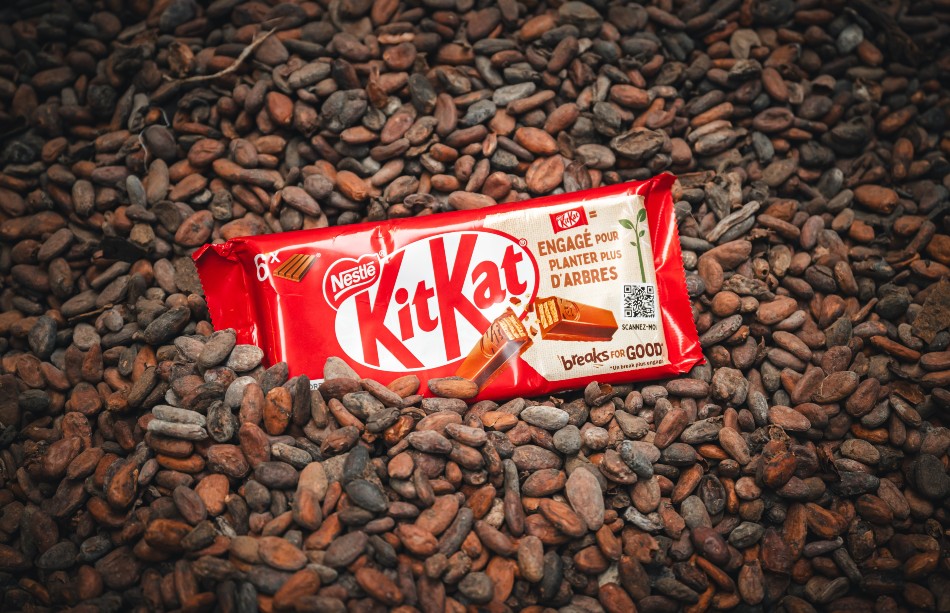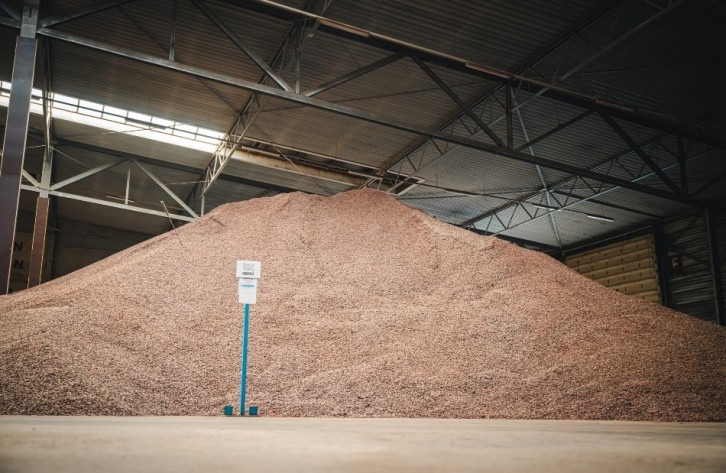Well-known for its advertising and marketing catchphrase, ‘Have a break – have a KitKat’, the brand new sustainable initiative that helps shut the dwelling revenue hole of cocoa-farming households and scale back little one labour danger in its provide chain, shall be recognized on a variation of the slogan: ‘Breaks for Good’.
The European launch of the programme came about at Nestlé’s Hamburg manufacturing unit the place a lot of the iconic bars at the moment are produced. The IAP was established in January 2022 to lift consciousness concerning the sustainability of cocoa mass from beans grown by farmer households engaged within the programme.
On the identical time, it strives to advance higher agriculture practices and promote gender equality, empowering girls as brokers for optimistic change. The programme incentivizes cocoa-farming households that enroll their youngsters at school, implement good agricultural practices, interact in agroforestry actions, and diversify their incomes.
Traceability requirements
Nestlé mentioned the cocoa mass from the revenue accelerator programme adheres to one of many highest traceability requirements, guaranteeing “combined identification preserved” traceability, enabling cocoa to be traced and saved individually.
The corporate additionally plans to make use of segregated cocoa butter, the opposite ingredient in chocolate bars, for all of its KitKats in Europe from the center of this 12 months, with plans to increase to different areas within the coming years.
“KitKat has constantly embraced innovation, centred round its iconic ‘Have a break, Have a KitKat’. At the moment, this innovation is dropped at life by means of the ‘Breaks for Good’ initiative that places cocoa farmers on the middle of our product by means of our revenue accelerator program,” mentioned Corinne Gabler, Head of Confectionery and Ice Cream at Nestlé. “We couldn’t consider a greater model than KitKat to characterize our efforts to create significant influence in cocoa communities.”
Nestlé’s revenue accelerator programme has to this point supported greater than 10,000 households in Côte d’Ivoire and is increasing into Ghana later this 12 months to incorporate a complete of 30,000 households. By 2030, the programme goals to succeed in an estimated 160,000 cocoa-farming households in Nestlé’s international cocoa provide chain to create an influence at scale.
Farmer revenue
The initiative has been launched towards rising considerations that farmers within the two West African nations, who between them account for greater than 70% of the world’s cocoa beans, have seen incomes, in accordance with Oxfam analysis, lower by 16% previously three years resulting from international market fluctuations, that is regardless of current premiums being paid farmers from certification schemes run by Fairtrade and Rainforest Alliance – and a Residing Revenue Differential (LID) cost of $400 per metric ton (MT) on all cocoa gross sales from Cote d’Ivoire and Ghana.
Darrell Excessive, International Cocoa Supervisor, Nestlé, mentioned the corporate calculated {that a} typical cocoa-growing household in West Africa requires roughly $6,300 a 12 months to dwell on. “Usually a household again in January 2022 was making $3,000 a 12 months per household, so there is a hole of about three and a half thousand for a dwelling revenue.”
He mentioned the IAP builds on Nestlé’s Cocoa Plan, the corporate’s in-house sustainability scheme, that has been working for 15 years to create a completely traceable provide chain. He defined to ConfectioneryNews that it has three pillars of motion. “Firstly, higher farming – and enhancing the farming practices to enhance yield and enhance revenue. It additionally improves the environmental credentials of the farm.
“The Second pillar is about enhancing the lives of the ladies and kids, and beneath the third pillar, it’s about reworking the provision chain of the cocoa from one which’s purchased as a commodity to 1 that is constructed on long-term relationships, proper again to the farmer, creating long run relationships and a clear provide of cocoa – so it is also a change of our cocoa provide.”
If all measures are fulfilled, cocoa farmers’ households will obtain a further €100. The cocoa farmers’ households obtain as much as €500 yearly for the primary two years after which €250 yearly. The studies from Nestlé suppliers present that since January 2022, the cocoa farmers’ households collaborating within the programme have obtained an estimated €2 million in incentives
Nestlé mentioned it has collaborated with varied companions and suppliers to remodel its international cocoa sourcing and obtain full traceability and bodily segregation of the cocoa sourced for its revenue accelerator programme. This may permit the corporate to trace all the journey of cocoa beans from origin to manufacturing unit whereas holding them bodily separated from different cocoa sources.
Youngster labour
The corporate imports roughly 350,000 tonnes of cocoa a 12 months, of which greater than 80% got here from the Nestlé Cocoa Plan in 2023. In 2024, an estimated 45,00 tonnes shall be segregated in its provide chain and assigned to the revenue accelerator programme. The beans from the Nestlé revenue accelerator arrive in Hamburg in their very own container, tracked with a barcode so organizations like Rainforest Alliance can certify they’re coming completely from the programme.
Alexander von Maillot, CEO of Nestlé Germany, mentioned: “The revenue accelerator is about offering the help and the motivation to assist them [cocoa farmers] make actually key modifications within the working of the family and the farm.”
He mentioned one of many key elements of the IAP is to get rid of the usage of little one labour within the firm’s provide chain: “It actually goes to the center that with this programme that we absorb particularly the dangers of kid labour as a result of we do not need any little one working … It is a way more life like programme than what we had previously, actually enabling households to have a greater revenue in order that youngsters can to go to highschool.”
von Maillot mentioned the IAP provides monetary incentives to farmers to enhance agricultural practices on the farm, higher pruning for instance, or rising different fruit bushes, and enhancing the environmental credentials of the land. There may be monetary help to ship youngsters to highschool, as a substitute of getting them work on the farm, and components to encourage different sources of revenue.
“So taking a typical farming family…they need one of the best for his or her youngsters, however we all know they’re struggling within the face of the problems like local weather change, cocoa pod illness, and the worldwide financial system.”
Excessive mentioned that the corporate desires all youngsters between six and 16 to be enrolled in and attending faculty.
“So, what we’re doing is issues like offering faculty kits for the youngsters, delivery certificates and we have been constructing faculties – we have constructed 68 faculties during the last 15 years in Cote d’Ivoire.”
“One other essential factor of the IAP is the significance of ladies. What we’re doing is de facto serving to the ladies firstly by serving to arrange village financial savings and loans associations (VSLAs), after which we add gender coaching to that for the family. We’re additionally utilizing cell cash to assist modernise the financial system and grow to be much less reliant on money funds.
“As a result of the money funds are extra auditable and traceable, it additionally implies that we all know we are able to actually be sure that the cash we’re paying our suppliers is then going from them on to the proper cocoa farming households and we actually needed to be sure that the ladies have been actually key to this. So, we be sure that half the motivation is paid to the ladies and half to the farmer.”
Excessive mentioned that in addition to the Rainforest Alliance certification, the programme can be evaluated by the impartial KIT Royal Tropical Institute.
Rainforest Alliance
Thierry Touchais, Rainforest Alliance’s organisation’s Strategic Accounts Supervisor, mentioned: “It is encouraging to discover a firm of this scale utilizing a ‘combined identification preserved’ mannequin through which cocoa may be traced again to Rainforest Alliance licensed farmers engaged in Nestlé’s revenue accelerator. The strategy showcases the potential for optimistic change within the business.”
He defined that the Rainforest Alliance’s position is twofold. “It is business and logistical, and when programming we’ve a novel place to help Nestlé on this venture, which has to do with our personal footprint and to ensure we’ve companions on the bottom to execute the work that should be carried out.”
von Maillot additionally defined the explanation why the manufacturing unit in Hamburg was chosen because the venue for the media launch of the IAP. “It’s as a result of it has been a key operation for Nestlé for the previous 50 years, producing over 4 million KitKat bars a day and exporting them to 26 nations. “
KitKats are nonetheless produced on the York manufacturing unit within the UK, the place the chocolate bar was invented in 1935 and a manufacturing unit in Sofia.
Cargill is one other of the principle companions dedicated to supporting Nestlé’s longer-term objectives and its progress on delivering the IAP for its chocolate manufacturers. It shops the cocoa in its warehouse on the Hamburg port.
Cargill
Michiel van der Bom, Product Line Director Cocoa & Chocolate Europe West Africa, Cargill, mentioned: “As a companion on Nestlé’s sustainability journey, we’re implementing options to supply sustainable substances for Nestlé in ways in which assist restore the surroundings, help households, and improve incomes. By means of our partnership, we’re constructing a stronger, extra resilient provide chain collectively.
He mentioned that in addition to sourcing cocoa on Nestlé’s behalf, Cargill can be liable for implementing the varied sustainable incentives within the IAP and, together with the Rainforest Alliance and Nestlé’s personal sustainability staff, continuously monitor the cocoa chain for full transparency.
“It is key that we’ve a powerful working and studying relationship with Nestlé in order that we additionally discover ways to implement programmes higher,” he mentioned.
He additionally confirmed that with the adoption of higher agricultural practices similar to pruning, Cargill can be noticing a rise in manufacturing from some cocoa farmers.
The KitKat ‘Breaks for Good’ shall be out there on retailer cabinets from this month in 27 European nations and from Could 2024 within the UK. As well as, a limited-edition KitKat, with 70% darkish chocolate that can be made with cocoa sourced from the revenue accelerator, has been launched within the UK market as a pilot.


